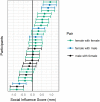The Influence of Co-action on a Simple Attention Task: A Shift Back to the Status Quo
- PMID: 29915553
- PMCID: PMC5994486
- DOI: 10.3389/fpsyg.2018.00874
The Influence of Co-action on a Simple Attention Task: A Shift Back to the Status Quo
Abstract
There is a growing consensus among researchers that a complete description of human attention and action should include information about how these processes are informed by social context. When we actively engage in co-action with others, there are characteristic changes in action kinematics, reaction time, search behavior, as well as other processes (see Sebanz et al., 2003; Becchio et al., 2010; Wahn et al., 2017). It is now important to identify precisely what is shared between co-actors in these joint action situations. One group recently found that participants seem to withdraw their attention away from a partner and toward themselves when co-engaged in a line bisection judgment task (Szpak et al., 2016). This effect runs counter to the typical finding that attention is drawn toward social items in the environment (Birmingham et al., 2008, 2009; Foulsham et al., 2011). As such, the result suggests that joint action can uniquely lead to the withdrawal of covert attention in a manner detectable by a line bisection task performed on a computer screen. This task could therefore act as a simple and elegant measure of interpersonal effects on attention within particular pairs of participants. For this reason, the present work attempted to replicate and extend the finding that attention, as measured by a line-bisection task, is withdrawn away from nearby co-actors. Overall our study found no evidence of social modulation of covert attention. This suggests that the line bisection task may not be sensitive enough to reliably measure interpersonal attention effects - at least when one looks at overall group performance. However, our data also hint at the possibility that the effect of nearby others on the distribution of attention may be modulated by individual differences.
Keywords: covert attention; joint action; joint attention; line bisection; replication; social presence.
Figures




References
-
- Aron A., Aron E. N., Smollan D. (1992). Inclusion of Other in the Self Scale and the structure of interpersonal closeness. J. Pers. Soc. Psychol. 63 596–612. 10.1037/0022-3514.63.4.596 - DOI
-
- Becchio C., Sartori L., Castiello U. (2010). Toward you: the social side of actions. Curr. Dir. Psychol. Sci. 19 183–188. 10.1177/0963721410370131 - DOI
LinkOut - more resources
Full Text Sources
Other Literature Sources
Research Materials

